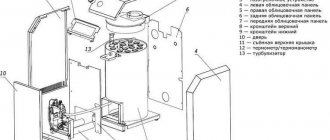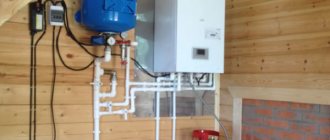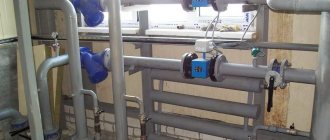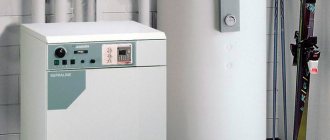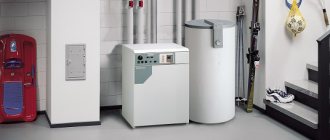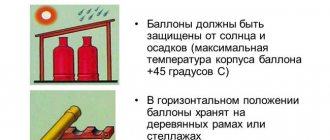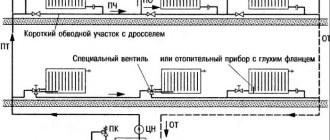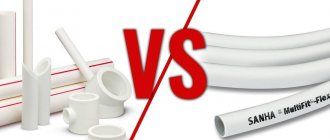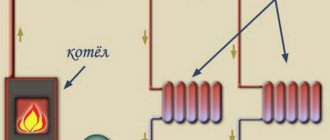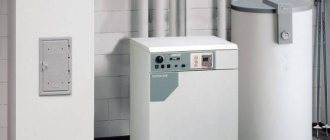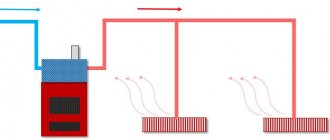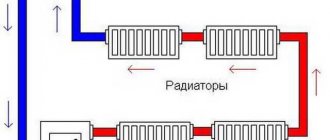An archaic fireplace looks beautiful, but the feasibility of its presence in a modern home raises doubts. I wouldn’t want to spoil the comfort of my home with soot. And the thought of a fire also worries me. It’s common to light a fire while relaxing in nature, but in your room it’s a little scary.
A safe solution would be a fireplace with a water heating circuit.
What is a fireplace with a water circuit
A fireplace is the oldest attribute of the interior of a human home. Since time immemorial, most family events have taken place around the hearth. Now you can buy a fireplace stove with a water heating circuit for the most sophisticated design.
Technological advances have led to a wide variety of designs for this traditional heat source. One of them is an aqua fireplace with the function of heating water circulating through the heating system. Now it can heat not just one room, but the entire house.
Principle of operation
A fireplace with a built-in water circuit works in the same way as a wood-burning stove for heating, which has a heating system heat exchanger built into its design.
Advantages
Installing a fireplace adds sophistication to the design. The room can be quickly warmed up when it gets cold outside or after a long absence from the country house. And the heating system of the entire building will start working immediately.
The benefits of purchasing an aqua fireplace do not end there:
- The fancifully shimmering flames are one of three paintings that you can look at endlessly. Relaxing by the fire is the most ancient, relaxing and soothing.
- The fireplace design does not contain moving mechanisms. There's simply nothing to break there. Durability is ensured by thousands of years of experience in using open fire.
- The aqua fireplace has a double body. Water from the house heating system circulates inside. The metal does not overheat from contact with an open flame, so the service life of the product is measured in decades.
- A traditional fireplace equipped with heat exchangers connected to the building's heating system has a coefficient of performance (COP) of 80%. This is the level of modern heat generators.
- A boiler can be connected to the aqua fireplace to provide the cottage with hot water supply.
- Fire safety is guaranteed by the use of a heat-resistant transparent firebox door. At the same time, the soft infrared spectrum of the flame freely penetrates through the glass, pleasantly warms the owners of the fireplace, and creates a cozy, warm atmosphere.
- Cheap fuel: firewood, coal, fuel briquettes - provides significant annual savings.
- Stove and fireplace heating is completely autonomous, which allows you to build a country house far from gas and electrical networks. The presence of a small-power electric generator makes it possible to use automated pellet feeding of the firebox for long-term continuous combustion.
- Modern aqua fireplaces are quite light. They can be installed without a foundation on a non-combustible base, for example, ceramic tiles.
- The varied designs of modern fireplaces have a common characteristic - compact sizes with a fairly high thermal output, which is important for small rooms.
- There is no inertia inherent in traditional massive furnaces. In a matter of minutes, a flaming flame will warm the room where the aqua fireplace is installed. If a circulation pump is provided, then the entire building is not afraid of sudden changes in outside air temperatures.
- The price of a massive stone fireplace or stove, together with the foundation and chimney, exceeds the cost of an aqua fireplace, the installation of which is quite simple, so it is possible to install it yourself. But it is now difficult to find a professional mason; his services are expensive.
- With a combined heating system, savings of up to 50% of the initial cost of gas equipment are possible. The maximum boiler power is calculated at the minimum winter temperature. At the latitude of Rostov-on-Don it is -24 °C. In practice, frosts rarely fall below -10 °C. When it gets colder, an aqua fireplace will help out. The rest of the time can be saved without sacrificing comfort.
Flaws
Modern people are spoiled by centralized heating of their homes, so even minor additional troubles with a fireplace can be very confusing.
However, there are not many problems:
- In strong winds, reverse draft is possible. Smoke and soot enter the room from the combustion chamber. To avoid such a nuisance, the chimney must rise above the ridge of the roof or be at a certain distance from it. The exact values for a specific case are calculated based on building codes and regulations (SNiP). Installing a deflector will help stabilize and increase traction.
- If a country house is not intended for permanent residence, then in winter the water from the heating system must be drained during absence. Otherwise the pipes will burst. The durability of the building and the safety of the interior will be guaranteed if the internal temperature is maintained at a level not lower than +10 °C. This can be achieved by automated pellet fuel supply or by installing an electric boiler for emergency heating.
- Installing a fireplace is more expensive than connecting an electric boiler. But electricity is one of the most expensive types of fuel. In addition, power outages are not uncommon.
- Regular cleaning of the chimney from soot is required 2 times a year, and more often with intensive use.
Main types of fireplaces for home and garden
Is it possible to efficiently heat a country house with a fireplace in winter? The answer is obvious - yes.
All fireplaces currently used for heating a home or cottage can be divided into two main categories:
- Fireplaces with open firebox.
- Fireplaces with a closed firebox.
People have been using open fireplaces for quite some time.
With their help, it was possible not only to heat the room (they were the main source of heat), but also to cook food.
Today, fireplaces with an open firebox successfully compete with fireplaces with a closed firebox, which can be of the following types:
- Fireplace with air heating.
- Fireplace with water heating.
The fireplaces listed above must include devices designed for heat recovery.
Main types of fireplaces. Click to enlarge.
Fireplace with open hearth
A fireplace of this type has proven itself excellently as a temporary heat source, since its power will not be enough for constant heating of medium-sized (in area) and large rooms and rooms.
An example of a fireplace with an open hearth. Click to enlarge.
The fact is that fireplace heating using equipment of this type (with an open firebox) is characterized by a very low efficiency - only 20% of the energy obtained from fuel combustion is used for heating, and 80% is heat loss, which simply “flies into pipe."
This feature of fireplaces with an open firebox is the basis for the fact that they consume almost twice as much fuel as fireplaces with closed fireboxes. The room in which the fireplace is located must be well ventilated, since in open fireboxes a constant flow of air is necessary to maintain the combustion process.
An open firebox requires unconditional compliance with primary fire safety rules:
- You should not leave coals unattended for a long time (at night, if you are away for a long time).
- The floor near the fireplace should be laid with non-combustible materials - decorative stone, tin, ceramic tiles, etc.
Fireplace with closed firebox
Heating with a fireplace with a closed firebox is characterized by more efficient energy consumption of fuel combustion - the efficiency can reach 75%.
Most often they are used as an additional supplier of thermal energy.
The fireboxes are made from excellent heat-accumulating materials that are highly resistant to rust and high temperatures.
The fire-resistant glass used to make doors can withstand temperatures up to +800°C, and the doors themselves can be mounted both horizontally and vertically.
Scheme of a fireplace with a closed firebox. Click to enlarge.
When calculating the thermal power of the firebox, you can adhere to the following proportion: 1 kW of power is required for 4 square meters of heated area.
The volume of the room in which the fireplace will be located must be at least 40-45 cubic meters.
The volume of air to constantly maintain the combustion process must be at least 10 cubic meters for one hour per kilowatt of power.
For example, to heat a house with a fireplace with a power of 5 kW, it is necessary to use about 50 cubic meters of air supplied through an air duct.
Fireplaces with a closed firebox can also heat adjacent rooms with certain schemes for using the heat of combustion of fuel.
Air or water heating with a fireplace involves the use of air or water as a heat-conducting material in such schemes.
What does it consist of?
The design is extremely simple: body, firebox, heat exchanger. The housing can be free-standing. It is sometimes embedded in a solid wall or a decorative frame made of brick, forged or stone sculptures. The firebox is steel, but the grates are usually cast iron. Welded heat exchanger made of seamless pipes. An air duct is connected to the bottom of the firebox, and a chimney is connected to the top.
Frame
The metal casing of the aqua fireplace is hollow inside. Water circulates between the outer and inner walls. This is where its heating begins, and then it enters the upper register of the heat exchanger. As a result of this technical solution, the outer shell cannot even theoretically heat up above 100 °C, therefore it is completely fireproof.
A hob is sometimes placed on the upper plane. This design is relevant for small country houses, where the kitchen, dining room and living room are combined in one room.
The geometry of the case depends only on the designer’s imagination. The main thing is that the combustion chamber fits in it.
The combustion chamber
Conventional fireplaces had a low efficiency of 20% due to imperfect heat extraction during fuel combustion. The room was heated by the infrared radiation of the flame. There was a large portal in front so that the rays from the fire could warm the maximum area of the room.
Additionally, a small amount of heat warmed the air in the house due to convective heat transfer from the hot body. The remaining 80% of the heat escaped through the chimney along with combustion products - hot gases.
The design of aqua fireplaces provides for the possibility of changing the fuel burning rate by regulating the flow of supply air into the lower part of the firebox. The portal is closed with heat-resistant glass. It blocks uncontrolled access of air to the fire, which makes the aqua fireplace fireproof.
To reduce the likelihood of drafts, provide for the flow of air into the firebox through a pipe. A fine grill to keep rodents and cats away is installed outside. There is an adjustable damper in front of the fireplace.
On top of the portal there is a “clean glass” system - a longitudinal slot with guides for a small amount of fresh air from the room. A stream of cold air “flows” along the inside of the glass, preventing soot contamination.
Heat exchanger (water heating circuit)
In the upper part of the firebox there is a register of pipes for collecting heat from hot gases. The coolant, water, flows inside the pipes. If the power of the aqua fireplace is very high, then additional registers are placed along the side and rear walls of the firebox. To improve heat transfer and increase efficiency, there must be a circulation pump. As a result, the efficiency of the aqua fireplace increases to 80%.
When heated, water increases its volume, so it is necessary to install an expansion tank. With an open heating system, it is installed at the highest point - usually in the attic. When closed, the membrane-type tank is mounted in any place convenient for maintenance. A pressure gauge and a safety valve are mounted nearby.
Chimney
Ceramics or metal are used to remove gaseous combustion products. Ceramic chimneys are durable, but expensive and labor-intensive to install.
The smoke channel pipe is glazed during manufacture. This prevents soot from sticking and makes cleaning easier. It is separated from the chimney body by heat-resistant thermal insulation. At the bottom there is a container for collecting condensate.
Main characteristics of ceramic chimneys:
- service life - over 25 years;
- glassy surface prevents soot deposition;
- fireproof;
- do not burn out;
- a significant mass must rest on the foundation;
- high cost of components;
- complex installation.
Metal chimneys are much cheaper and easier to assemble. If the operating mode is violated, they may burn out.
Steel pipes are assembled using a sandwich design. The inner pipe made of technical stainless steel is separated from the outer one by fiber-basalt thermal insulation. Individual blocks are joined using heat-resistant sealant.
Characteristics of metal chimneys:
- the cost of purchase and installation is less than that of ceramics;
- it is possible to assemble it yourself;
- light weight, so no foundation is needed;
- Do not allow the flame to break through into the chimney.
Main components
Fireplaces for heating a country house can heat several rooms at once only if the project is correctly, competently compiled and implemented.
If you wish, you can make a heating fireplace for your home yourself. To do this, it is imperative to familiarize yourself with the main components of such a device:
- Portal. The fireplace frame is one of the main, integral elements. The portal is responsible for the stability and reliability of the structure; in addition, this element makes the fireplace visually more attractive. Frames can have different shapes, dimensions, finishes, and styles. They also allow the hearth to warm up better and produce a higher efficiency at the output;
- Hearth. This component is the main, central one in the entire structure. The outbreak can be open or closed. A fireplace for heating several rooms must have a closed hearth. It is not only more efficient, but also guaranteed to be safe from a fire point of view. Open fireboxes are purely decorative. fireplace inserts with air heating can be either made of refractory fireclay bricks or purchased in a fully assembled state (metal, ceramic, cast iron);
- Doors. Closed combustion chambers are always equipped with one or more doors. They are necessary to protect and increase the efficiency of the heating unit. Many manufacturers make this element from transparent tempered glass installed in a cast iron or steel frame. Thus, you can admire and control the flame in the firebox without opening it;
- Cleaning doors. Any fireplace, especially one that burns solid fuel, needs to be cleaned periodically. Soot and soot accumulate in the chimney, ash pan and other components of the device. To more conveniently remove such deposits, cleaning doors are used. They can be located in one or several places of the chimney;
- Grate. To control the degree and intensity of flame combustion in solid fuel fires, a grate is used, and logs are placed on it. In the future, by adjusting a special damper, you can increase or decrease the power of the fireplace and the heat of the flame with your own hands;
- Ash pit. Solid fuel structures are characterized by the presence and formation of sediment. In order to get rid of combustion products remaining in the fireplace and clean the stove, a grate is installed. It is often represented by a retractable structure, which is easy to clean and remove the remains of burnt coal and logs.
Main components of a solid fuel heating unit
Fireplaces with a water circuit are more efficient: the photo shows the operating principle of such installations
Method of placing a wood-burning fireplace in a one-story building
Advice: if you do not have enough experience in drawing up fireplace heating projects, constructing this type of building with your own hands, it would be best to entrust the assembly and installation of the heating device to a professional stove maker!
Fireplace heating of private houses requires an individual approach, the professional work of a craftsman who can carry out all the work and draw up a drawing, not only according to your wishes, but also based on the individual characteristics of the building itself.
Types of fireplaces
Wood-burning stove-fireplace
This modification arose as a result of a natural desire to replace a conventional wood-burning stove in a country house with an aesthetic fireplace. To do this, it was necessary to increase its efficiency.
The problem was solved by three design improvements:
- The air flow into the firebox is not through the open frontal plane, but through the grates from below. The intensity of fuel combustion is regulated by the position of the gate in the ash pit.
- The portal is closed with transparent heat-resistant glass. Infrared rays pass through it freely, heating the entire room.
- A heat exchanger is installed on top of the firebox.
Pellet fireplace
An alternative option was developed after the invention of pellets - granulated fuel from peat, organic waste from the woodworking industry, and agriculture. Standardization of the size of the new type of biofuel made it possible to automate the combustion process as much as possible.
The frequency of servicing the aqua fireplace has changed from several hours to a month. Ignition, control, and regulation of the process are carried out by a built-in controller.
The design of any pellet stove consists of several systems:
- Storage facility with gravity fuel supply system. As the granules are consumed, they fall down the inclined surface to which the vibration mechanism is connected.
- Fuel line with vacuum pump or screw doser.
- Built-in fireplace receiving hopper.
- Combustion chamber with flame control.
- Periodic cleaning of the chimney and ash chamber using spring mechanisms.
As the pellets burn out, fuel is supplied from the built-in hopper. The intensity of the supply of granules is automatically adjusted depending on the set room temperature and changes in weather conditions.
When the bunker is empty, the supply of biofuel is periodically switched on through a fuel line from the storage facility, the dimensions of which determine the duration of operation of the entire system without rebooting.
Gas fireplaces, Gas fireplace inserts
You are here: Home > Product catalog > Gas fireplaces, Gas fireplace inserts| Power, kWt) | 1,6 — 4,6 |
| Heating (m3) | 90 |
| The combustion chamber | Steel |
11,300 rubles
Gas stove-fireplace INFIRE FLOOR TG-5000 SHR
| Power, kWt) | 2 — 5,8 |
| Heating (m3) | 120 |
| The combustion chamber | Steel |
12,000 rubles
Gas stove-fireplace INFIRE FLOOR AG-4000 AT
| Power, kWt) | 1,6 — 4,6 |
| Heating (m3) | 90 |
| The combustion chamber | Steel |
13,600 rubles
Gas fireplace INFIRE FLOOR TG-6000 NGR
| Power, kWt) | 2 — 6,8 |
| Heating (m3) | 120 |
| The combustion chamber | Steel |
15,200 rubles
Gas stove-fireplace INFIRE FLOOR AG-9000 AT
| Power, kWt) | 3,8 — 10,5 |
| Heating (m3) | 210 |
| The combustion chamber | Steel |
15,200 rubles
Gas fireplace INFIRE FLOOR TG-9000 OFG
| Power, kWt) | 3,8 — 10,5 |
| Heating (m3) | 210 |
| The combustion chamber | Steel |
17,900 rubles
Gas burner for fireplace INFIRE INSIDE-50 FARAON
| Power, kWt) | 3 — 10 |
| Heating (m3) | 60 — 200 |
| The combustion chamber | Cast iron |
18,200 rubles
Gas fireplace INFIRE FLOOR 6000 JA-200
| Power, kWt) | 2 — 6,8 |
| Heating (m3) | 140 |
| The combustion chamber | Steel |
21,700 rubles
Gas fireplace INFIRE FLOOR TLC-12000 ADR
| Power, kWt) | 4,5 — 14 |
| Heating (m3) | 280 |
| The combustion chamber | Steel |
22,100 rubles
Gas fireplace INFIRE FLOOR TG-12000 NGN
| Power, kWt) | 4,5 — 14 |
| Heating (m3) | 280 |
| The combustion chamber | Steel |
22,100 rubles
Gas fireplace INFIRE FLOOR 6000 JA-220 IRON
| Power, kWt) | 2 — 6,8 |
| Heating (m3) | 140 |
| The combustion chamber | Steel |
22,200 rubles
Gas convector Hosseven HP 3
| Power, kWt) | 3 |
| Heating (m3) | 60 |
| The combustion chamber | Steel |
22,300 rubles
Gas fireplace INFIRE FLOOR 9000 SH-250 White
| Power, kWt) | 3,8 — 10,5 |
| Heating (m3) | 210 |
| The combustion chamber | Steel |
23,900 rubles
Gas fireplace INFIRE FLOOR 6000 JA-220 WOOD IRON
| Power, kWt) | 2 — 6,8 |
| Heating (m3) | 140 |
| The combustion chamber | Steel |
23,900 rubles
Gas fireplace INFIRE FLOOR 9000 JA-350
| Power, kWt) | 3,8 — 10,5 |
| Heating (m3) | 210 |
| The combustion chamber | Steel |
24,900 rubles
Gas fireplace INFIRE FLOOR 9000 NC-25
| Power, kWt) | 3,8 — 10,5 |
| Heating (m3) | 210 |
| The combustion chamber | Steel |
25,900 rubles
Gas convector Hosseven HP 5
| Power, kWt) | 5 |
| Heating (m3) | 100 |
| The combustion chamber | Steel |
26,800 rubles
Gas fireplace INFIRE FLOOR 9000 JA-350 WOOD
| Power, kWt) | 3,8 — 10,5 |
| Heating (m3) | 210 |
| The combustion chamber | Steel |
27,700 rubles
Gas burner for fireplace INFIRE INSIDE-50
| Power, kWt) | 3 — 10 |
| Heating (m3) | 60 — 200 |
| The combustion chamber | Cast iron |
28,300 rubles
Gas fireplace Infire Floor IRON-9000
| Power, kWt) | 4,5 — 12 |
| Heating (m3) | 240 |
| The combustion chamber | Steel |
29,700 rubles
Gas convector Hosseven HS 8
| Power, kWt) | 8 |
| Heating (m3) | 160 |
| The combustion chamber | Steel |
29,800 rubles
Gas fireplace INFIRE FLOOR 9000 JA-280 IRON
| Power, kWt) | 3,8 — 10,5 |
| Heating (m3) | 210 |
| The combustion chamber | Steel |
31,700 rubles
Gas fireplace INFIRE FLOOR 9000 IM-340 IRON
| Power, kWt) | 3,8 — 10,5 |
| Heating (m3) | 210 |
| The combustion chamber | Steel |
31,900 rubles
Gas convector Hosseven HP 8
| Power, kWt) | 8 |
| Heating (m3) | 160 |
| The combustion chamber | Steel |
32,500 rubles
Gas fireplace insert Infire Inside-50 AMINA
| Power, kWt) | 3,8 — 10,5 |
| Heating (m3) | 210 |
| The combustion chamber | Cast iron |
33,500 rubles
Gas fireplace INFIRE FLOOR 12000 NC-30
| Power, kWt) | 4,5 — 14 |
| Heating (m3) | 280 |
| The combustion chamber | Steel |
33,800 rubles
Gas convector Karma Beta2 Mechanic Comfort
| Power, kWt) | 2 |
| Heating (m3) | 40 |
| The combustion chamber | Steel |
37,500 rubles
Gas convector Karma Beta3 Mechanic Comfort
| Power, kWt) | 3 |
| Heating (m3) | 60 |
| The combustion chamber | Steel |
39,900 rubles
Gas convector Karma Beta4 Mechanic Comfort
| Power, kWt) | 3,9 |
| Heating (m3) | 80 |
| The combustion chamber | Steel |
42,900 rubles
Gas fireplace INFIRE FLOOR 9000 NC-110
| Power, kWt) | 3,8 — 10,5 |
| Heating (m3) | 210 |
| The combustion chamber | Steel |
44,000 rubles
Gas burner for fireplace INFIRE INSIDE-40 AFINA
| Power, kWt) | 3,8 — 10,5 |
| Heating (m3) | 210 |
| The combustion chamber | Cast iron |
48,900 rubles
Gas fireplace Infire Floor 9000 Versace-280
| Power, kWt) | 3,8 — 10,5 |
| Heating (m3) | 210 |
| The combustion chamber | Steel |
49,000 rubles
Gas fireplace INFIRE PATIO-100
| Power, kWt) | 6-12 |
| Heating (m3) | 100 — 250 |
| The combustion chamber | Stainless steel |
57,000 rubles
Gas fireplace INFIRE WALL-100
| Power, kWt) | 6-12 |
| Heating (m3) | 100 — 250 |
| The combustion chamber | Stainless steel |
59,500 rubles
Gas fireplace INFIRE WALL Classic L-150
| Power, kWt) | 3,8 — 10,5 |
| Heating (m3) | 210 |
| The combustion chamber | Steel |
110,000 rubles
Gas fireplace KARMA ABSOLUTE 01 (4.2 kW)
| Power, kWt) | 4,2 |
| Heating (m3) | 80 |
116,760 rubles
Gas fireplace INFIRE FLOOR ART CL-100
| Power, kWt) | 3,8 — 10,5 |
| Heating (m3) | 210 |
| The combustion chamber | Steel |
130,000 rubles
Gas fireplace INFIRE WALL FLAME
| Power, kWt) | 3.6 — 8.9 |
| Heating (m3) | 180 |
| The combustion chamber | Steel |
295,000 rubles
Gas fireplace INFIRE ART CLASSIC 90 + FRAME LADY
| Power, kWt) | 3,8 — 10,5 |
| Heating (m3) | 210 |
| The combustion chamber | Steel |
340,000 rubles
| Gas fireplace INFIRE FLOOR 9000 NC-110 | Gas fireplace INFIRE WALL-100 TRIPLE |
| Gas fireplace INFIRE FLOOR JA 280 IRON | Gas fireplace INFIRE PATIO-100 |
| Gas fireplace INFIRE FLOOR 12000 NC-30 | Gas fireplace INFIRE WALL 100 |
| Gas fireplace INFIRE FLOOR 9000 JA 350 | Gas fireplace INFIRE INSIDE-50 AMINA |
| Gas fireplace INFIRE FLOOR 9000 IM 340 IRON | Gas burner for fireplace INFIRE INSIDE-40 AFINA |
| Gas fireplace INFIRE FLOOR TG 6000 NGR | Gas burner for fireplace INFIRE INSIDE 50 |
| Gas fireplace INFIRE ART CL-100 | Gas burner for fireplace INFIRE INSIDE 50 |
Gas fireplaces INFIRE FLOOR are an option for inexpensive heating of a country house or country cottage. Steel gas fireplaces INFIRE FLOOR are by no means a decorative heater, as is the case with electric fireplaces; the visible combustion process will delight you on cold winter evenings and add comfort to your home. INFIRE FLOOR gas fireplaces and stoves use an open combustion chamber.
In the room where the gas fireplace is installed, there must be a constant flow of fresh air. It is not recommended to install a fireplace stove in rooms with a volume of less than 6 m³ or with a floor area of less than 2.5 m². A draft sensor is installed in the chimney. The draft in the chimney is controlled automatically. Technical characteristics of gas fireplaces INFIRE series FLOOR Dimensions of gas fireplaces INFIRE series FLOOR
Iranian gas fireplace stoves have proven themselves to be reliable and high-quality equipment. It is possible to buy Iranian-made gas fireplaces from NBC in the store. Price of gas fireplaces Iran.
Types of fireplaces by material of manufacture
To construct aqua fireplaces, brick, natural stone, ceramics, cast iron, steel sheet, basalt fiber insulation, and heat-resistant glass are used.
Brick
The fireplace stove can be custom-designed to almost any configuration. Finishing with tiles will emphasize the individuality of the interior. As a rule, high-quality working bricks (refractory) are used in such fireplaces.
Requires careful adherence to technology and high-quality installation. Installed on a separate foundation. The high starting cost is justified by the increased comfort.
Metal
The most profitable due to the optimal price/quality ratio. Light weight, affordable price, simple installation, and varied designs contribute to their widespread distribution.
Combined
They combine the comfort of infrared fireplace heating, the heat capacity of a massive stove, and the functionality of a water heating system. They have the highest possible efficiency. They release accumulated heat for a long time after the fire goes out.
A combustion chamber with a heat exchanger is built in during the construction of a brick or stone fireplace facade. Since access for repairs will be difficult later, the cast iron option is optimal. A separate foundation is required, so it is recommended to use a durable ceramic chimney.
Criterias of choice
When choosing, most buyers are guided by cost and their own taste, paying attention only to the appearance of the product.
It is also advisable to take into account other factors:
- thermal power;
- durability;
- burning duration of a disposable fuel filler.
Power is determined depending on the size of the house area and the minimum outdoor temperature in winter. The manufacturer indicates the corresponding characteristics in the product passport. If they are not there or the numbers are very approximate, then you can use the calculation method from SNiP.
Then you need to consider:
- climatic conditions in the place of residence;
- design characteristics of premises;
- size of heated area;
- number of external walls;
- orientation of the external walls according to the cardinal directions - south, east, west, north;
- thermal resistance of external walls, depending on the thickness and thermal conductivity of the material;
- outside air temperature during the coldest week of winter;
- ceiling height;
- what is below/above: a heated or cold room, an attic - insulated or not;
- degree of floor insulation;
- presence of a basement;
- number/size of windows;
- window design: wood or metal-plastic, double or triple glazing, argon filling;
- presence/size of doors to the street or balcony.
Each room must be counted separately. Then sum up the heat loss - this is the maximum power of the heat-generating unit, which will still need to be increased by a safety factor of 15-20%.
How is safety ensured when using a gas fireplace?
Modern gas fireplaces are equipped with several automatic safety systems:
1) Checking gas pressure.
Internal structure
The gas supply system provides and maintains constant pressure, and the built-in sensor monitors the process and automatically stops the gas supply in case of any violations.
2) Air analyzers.
Another sensor is atmospheric. They constantly check the condition of the air in the room, determining the level of carbon dioxide formed during combustion, and if the norm is exceeded, they automatically issue a command to turn off the gas supply.
3) Infrared sensors.
Their task is to monitor the position of the fireplace. If for some reason the fireplace unexpectedly tips over, infrared sensors will detect this and instantly stop the fireplace from working.
The main parameters that you should pay attention to when choosing a gas fireplace
Nowadays you can find a large number of different gas fireplaces on sale - both domestic and imported. There may be some difficulties hidden here: for example, fireplaces from European manufacturers are designed to be connected to a gas supply system, the pressure in which exceeds the pressure considered normal for the Russian network.
In the hall
In order not to make a mistake with the dimensions, you need to measure everything in advance, draw up a drawing, take into account the height of the rooms, the location of beams and rafters, furniture, and do not forget that there should be enough free space around the portal.
2) Installation type.
The following options are possible here:
- floor installation - the floor must be insulated using a special high-temperature-resistant coating;
- built-in installation - requires cladding, preparation of the base, creation of a frame, it is more difficult to install a chimney (the firebox is built inside a load-bearing wall);
- wall installation - hung on the wall;
- outdoor installation - placed on the street (this is the simplest option in which you can do without a chimney).
3) Gas consumption.
Gas consumption may vary. Typically, the manufacturer indicates the maximum level of gas consumption in the product characteristics. This parameter is especially important if liquefied gas is planned as a fuel source for the fireplace, because it is much more expensive than natural (household) gas. However, models running on liquefied gas also have their advantages - they are usually mobile, i.e. they can be moved wherever you want, and they do not have the difficulties of connecting to the gas network.
4) Power level.
This parameter determines how much area of the room the fireplace can heat. Most
Installation in the room
The common power range is from 5 to 10 kW (models with a power of up to 13 kW are available).
5) Material for making the firebox.
Most often this is cast iron or stainless steel. Cast iron fireboxes are heavier and less common than steel ones. The inside of the firebox can be lined with various refractory materials.
6) Availability of additional functionality.
It can be anything: a remote control, an electric ignition option, various sensors and control systems, support for a given temperature, etc.
Popular models and their costs
Angara Aqua
Power 16 kW, dimensions 104 x 70 x 45 cm, weight 205 kg, cost from 32,000 rubles.
A characteristic feature is the convection grille in the upper part. Designed for accelerated heating of ambient air.
Prices for the Angara Aqua fireplace model
hangara aqua
Pechora Aqua
Power 18 kW, dimensions 104 x 75 x 49 cm, from 40,000 rubles.
The firebox is lined from the inside with a refractory lining. The prismatic side walls are decorated with ceramics. The convection niche is enlarged and can be used to heat food instead of a microwave.
Prices for the Pechora Aqua fireplace model
pechora aqua
MBS Thermo Vesta plus
Power 11 kW, dimensions 89 x 46 x 44 cm, 42,650 rub.
A diverse range of models is achieved by the capabilities of high-quality cast iron casting of component parts. The decent-sized upper platform allows you to boil a kettle or even prepare a simple dish. In this case, there is no heat exchanger.
Prices for the MBS Thermo Vesta plus fireplace model
MBS Thermo Vesta plus
EcoFireplace Alsace
Power 11 kW, made in Germany, dimensions 97 x 145 x 49 cm, RUB 189,900.
The external beauty and versatility of using tiles for external cladding are captivating. But it is completely unclear how the declared 80% efficiency is achieved. There are no water heat exchangers.
EcoFireplace Bavaria with stove and heat exchanger
Power 11 kW, dimensions 945 x 710 x 540 mm, RUB 47,200.
Increasing the volume of the firebox in width made it possible to obtain increased thermal power. This created enough space for the location of the cooking zones. A convenient option for small country houses with a combined kitchen-dining room. The prismatic glass facade heats almost the entire room.
MBS VULKAN
Power 17 kW, dimensions 85 x 48 x 60 cm, 66,440 rub.
A powerful, squat stove, solid and reliable.
La Nordica Termo Cucinotta
Power 9.1 kW, dimensions 68 x 86 x 65 cm, from RUB 178,400.
Italians are recognized trendsetters not only in clothing and shoes. Some fireplace models are worthy of installation in a royal palace. The advertised system of “tertiary combustion” of fuel may raise doubts among a professional boilermaker. At the same time, the declared efficiency of 78.8% is quite realistic in the presence of a water heat exchanger.
DIY making
Construction of a fireplace without relevant experience is possible if you have detailed drawings indicating the order of laying bricks. First, a concrete foundation is poured or it is laid out from blocks to the level of the subfloor. Waterproofing from roofing felt is installed on top.
It is advisable to use fireclay products for the firebox. The heat exchanger is preferably made of cast iron, but a welded pipe register with a wall thickness of at least 4 mm is suitable. The connections of the heat exchanger with the heating pipes must be located outside the firebox.
The rest is built from refractory bricks with clay mortar. After forming the vault, a chimney is mounted on top. It can be built without pipes from bricks at the back of the fireplace on its own foundation.
Before igniting after completion of construction, you must wait two weeks. Then fill the system with water. Carry out the first fire in a gentle mode, gradually increasing the flame.
What is a fireplace?
A fireplace is a type of stove that generates heat by burning solid fuel. The classic option is firewood, just like a regular wood-burning boiler, but you can heat the fireplace with coal, and special briquettes or pellets. Fuel burns due to air draft created by the design of the fireplace. The blower channel ensures the flow of cold air into the main chamber where combustion occurs. The smoke goes into the smoke collector and is then discharged through the chimney, providing sufficient draft for the active combustion process of wood. The resulting heat is distributed throughout the house depending on the design of the fireplace.
The fireplace consists of four main parts:
- Portal. This is the external, frontal part of the fireplace, which has both a structural and decorative function. It can be made of brick, natural stone, marble, artificial stone. The portal is decorated with various decors; it can be made in any style that suits the interior of the house. The upper part is used as a mantelpiece.
- Firebox. This is the central part of the fireplace, the chamber in which fuel is burned and heat is produced for heating. To make the firebox, fire-resistant metal or heat-resistant brick is used. It may be open or have a door.
- Hailo (smoke collector). Only needed for fireplaces with an open firebox. It is a special chamber where smoke is collected before entering the chimney.
- Chimney. A vertical pipe for removing smoke outside the house, providing draft for active combustion of fuel in the main chamber of the fireplace.
If in your home there are restrictions related to the organization of the chimney or you are put off by the need to prepare firewood for a wood-burning fireplace, you can opt for a bio-fireplace. You can buy a fireplace that does not require burning wood to operate on the Biokamin.rf website. There you can also find traditional solutions in various configurations.
The fireplace has several varieties, each of which has its own design features, and therefore fireplaces are classified according to several criteria.
Self-installation
Modern lightweight models are standardized and therefore do not require much effort during installation. You will need a standard set of tools, minimal skills, and some free time.
Fireplace installation
Before installation, it is necessary to equip a non-combustible base made of steel sheet or ceramics.
Further according to the manufacturer's instructions:
- Install the fireplace level strictly vertically.
- Connect the heat exchanger to the heating system pipes.
- Mount the chimney and attach it to the firebox.
- Fill with water.
- Add half the fuel and light it up.
Connection to radiators
The aqua fireplace is compatible with both open and closed heating systems. For the main line, choose a pipe of at least 1.5 inches. It is mounted with a constant slope of at least 5 degrees. Radiators are connected with 1/2-3/4 inch taps.
Chimney installation and connection to the fireplace
The connection can be at the top or rear of the firebox.
The following rules must be observed:
- The diameter of the chimney must be equal to or larger than the outlet in the fireplace.
- A damper must be installed on the chimney.
- Horizontal sections cannot be more than 1 meter.
- The height of the chimney must correspond to the passport height.
- Intersections with ceilings and walls are insulated with non-combustible materials.
- There should be a revision on the chimney to remove soot, and at the bottom there should be a receiving bowl for condensate.
MULTIVISION 7000 HYDRO – SEGUIN
The production of this cast iron firebox is carried out by the famous French company SEGUIN. Thanks to the material from which the fireplace chamber is made, it does an excellent job of producing and distributing heat.
To prevent smoke leakage, a special patented door locking system was used in the development of this model.
MULTIVISION 7000 HYDRO – SEGUIN is made according to the European standard NF D 35376. There is an adjustable gate and a deflector. A guarantee of safety is the strength of the wall, achieved due to its thickness - 8-12 mm; this criterion also increases the duration of use.
There are 5 options for the arrangement of glass and doors.
Features of the MULTIVISION 7000 HYDRO – SEGUIN firebox:
- Power is 15 kW, maximum – 24 kW;
- Efficiency – 75%;
- Weight – 180 kg;
- Width, height, depth: 71 cm; 55.5 cm; 49.5 cm;
- The chimney diameter is 20 cm.
Recommendations for use and care
The use of fire in the house clearly implies increased attention to fire safety. In addition to the wood box, a bucket of sand and a fire extinguisher would also be useful next to the fireplace.
The maintenance method is practically no different from traditional methods:
- periodically monitor the water level or pressure;
- Clean the chimney of soot twice a year;
- remove ash regularly;
- wipe the fireplace glass with special liquids;
- Before the seasonal start-up, inspect the pipe connections;
- In winter, before leaving your country house, drain the water from all pipes.
The best corner electric fireplaces
Dimplex Avola
Floor-standing electric fireplace operates silently, there are no sounds of simulated combustion. Adjustment between two heating modes and a mode without heat supply, decorative function only. Built-in fan heater. Made in a modern style, decorative grille, fuel - firewood.
Advantages:
- Nice modern design.
- Small dimensions in height, width and depth.
- Operation without heating, only decorative mode.
- Good imitation of flame.
- Easy installation, portable.
Flaws:
- No burning sound.
- Does not come with a remote control.
Inexpensive fireplace with a beautiful design. Price - 14,500 rubles. Its main advantage is its portable design: if necessary, it can be moved to any room. One of the inconveniences is the lack of a remote control; if the ability to control the fireplace remotely is important, take a closer look at the corner structures with remote controls that we reviewed above, for example, Electrolux Classic EFP/P-1020LS.
Dimplex Avola works quite powerfully for heating - 2 kW, the next model in the rating - RealFlame Elford Corner AO+Rimini - works with a power of 1.5 kW.
RealFlame Elford Corner AO+Rimini
Electric fireplace with portal, imitation white stonework. A 2D effect is used, simulating burnt firewood. The rear glass is mirrored. It works in two modes - heating and decorative. The design is classic, the finish is white brick and wood.
Advantages:
- Heating adjustment in two modes and decorative mode.
- Overheat protection.
- 2D flame imitation effect.
- Nice design.
Flaws:
- There is no simulated burning sound.
- Does not come with a remote control.
The price of the fireplace is higher than that of the previous model - 31,900 rubles. Externally, they are radically different: Dimplex Avola is modern minimalism, RealFlame Elford Corner is a brick classic. Otherwise, the fireplaces do not differ in functionality, except for the heating power, as I said above - Dimplex is more powerful.
